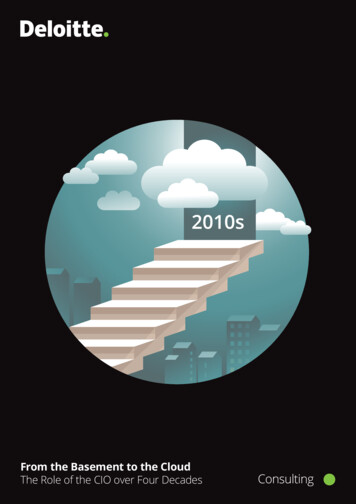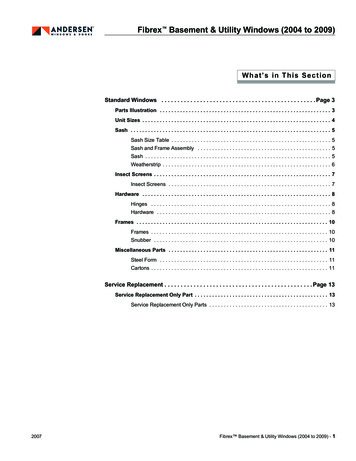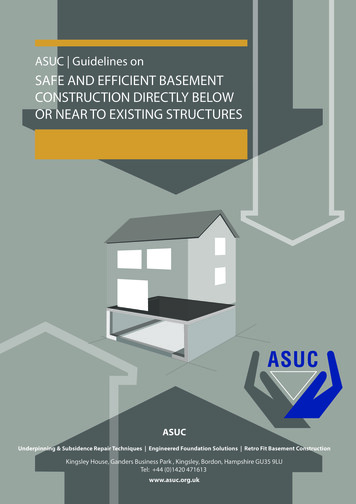
Transcription
From the Basement to the CloudThe Role of the CIO over Four Decades
From the Basement to the Cloud The Role of the CIO over Four DecadesCem DoganDeloitte ConsultingExecutive SummaryAdvances in information technology (IT) transformthe role of IT executives and among them therole of the Chief Information Officer (CIO) sinceits incarnation in the 1980s. This article describesthe current evolvement of the CIO role into a“technology architect.”In this decade of the 2010s, the role of the CIOis constituted by tasks of increasingly integratingand configuring external IT resources besidesacquiring and managing in-house IT resources.A theoretical framework is developed of theemerging technology architect CIO role based onanalyses of 16 interviews with leading global CIOs.We reflect decade-specific Information Systems (IS)research considering the CIO roles’ overall impacts,its tasks, and its contributions to the organizationto reason and compare the CIO’s evolving role fromthe 1980s over the 1990s and 2000s to the 2010s.2
From the Basement to the Cloud The Role of the CIO over Four DecadesThe Evolving Role of the CIOThe role of the CIO enters its fourth decade, successivelychanging over time. Outlining the future understanding of the CIO,this article is to be reflected on cloud computing, social media,mobility, and IT servitization.The different incarnations of the CIO along the decades of the1980s, 1990s, 2000s, and 2010s are categorized as follows.In the 1980s, the CIO emerged as a C-level executive responsiblefor establishing and managing the organization’s IT department.1Associating the role closely with firms’ IT facilities and basementdata centers, the CIO was mainly a “technology developer”throughout this decade and closely responsible for programmingIT infrastructures of the organization.Reflecting the current and past three decades,2 our researchidentifies four archetypical roles of the CIO and relates themto their 1) impacts, 2) tasks, and 3) contributions as illustratedin Figure 1. Based on these three dimensions, we contrast thecharacteristics of each evolved role with events in technology thatoccurred. Our findings regarding the CIO role of the 1980s, 1990s,and 2000s are based on the first part of our interviews, where weasked our interviewees what they “relate with the CIO function ofthe past three decades” (Appendix B), and backed up by academicstudies. Our findings regarding the CIO role in the 2010s arebased on a structured analysis of the qualitative data from themain interview parts using grounded theory.A decade later, in the 1990s, the CIO increasingly includedbusiness and service responsibilities in addition to technology.Aligning technology to business models became a central concernand classified the CIO as a “technology aligner” who understandsthe business. Internet technology became a critical businessdriver and made CEOs include their CIOs in helping to design anddefine new business models.In the 2000s, close relations among CIOs and business units areobservable due to massive initiatives in IS integration throughoutorganizations. CIOs become recognized as top executive teammembers. Operative technological responsibilities shift towardsroles such as to Chief Technology Officers (CTOs). The CIO’sposition in the top management team as a “technology integrator”starts to increase both the effectiveness of how technology isused and how synergies are created within organizations, thusincreasing overall company performance.The current understanding of the CIO in the 2010s evolvestowards a “technology architect”. Rapid business changes andgrowths shift CIOs’ responsibilities towards integrating externallyavailable IT services, such as web services from cloud platforms,and creating holistic accessibility of available technology.Companies’ technological competitive advantages are determinedby their flexible use of IT resources, in order to scale existing andadapt new technologies, which can be achieved if IT knows whatthe corporate building blocks are and how they fit together.Rockart, J. F., Ball, L., and Bullen, C. V. “Future Role of the Information Systems Executive,” MIS Quarterly (6:Special Issue), 1982, pp. 1–14.Ross, J. W., and Feeny, D. F. “The Evolving Role of the CIO,” in Framing the Domains of IT Management, Zmud, R. W. (ed.), Pinnaflex Press, 2000, pp. 385–401: In the mainframeera that was “covering roughly the 1960s into the early 1980s [ ], IT was largely synonymous with mainframe computers.” In the distributed era that was “starting at the endof the 1970s [ ], corporate IT became characterized by integrated networks of workstation PCs, mini-computers and mainframes, connected through local and wide areanetworks.” The web-based era was “starting for most in the mid-1990s, with a rapidly growing emphasis on the use of internet and web protocols to drive both internally andexternally oriented applications of IT.”123
From the Basement to the Cloud The Role of the CIO over Four DecadesFigure 1: Comparison of the CIO role over four decades between the 1980s and 2010sThe CIO, a technology developer (1980s)The CIO emerged from prior IT leadership roles in the early 1960s.After Apple launched its first home computer in the late 1970s,IBM released its first MS-DOS-based personal computer in theearly 1980s. In the mid-1980s, Microsoft introduced Windows 1.0while Technology started to attract mainstream awareness. Asa “technology developer”, the CIO was dedicated to introducingtechnology to organizations by that time.1. Impacts on the CIO in the 1980sWhile during the 1960s and 1970s the quantity of data processorsto produce information was important, the quality of informationbecame crucial for companies in the 1980s, as the mainframe erawas maturing and the distributed era started to fade in. By thattime, the impacts on the CIO were strongly Technological2. Tasks of the CIO in the 1980sCIOs assigned decentralized IT managers for coordinatingcorporate data processing. They needed to be perceptive inmanaging IT teams and in communicating and transferring theirtechnical competencies to them.3 As a software developer himselfand a manager of a technical team of developers, the CIO neededto be increasingly aware about building human relationships andassign responsibilities to his technical team. Their main tasks inthe 1980s were therefore related to Developing IT infrastructure Assigning IT workforce3. Contributions of the CIO in the 1980sCIOs built the interface between the IT workforce and hisorganization’s executive management. As the leader of thecorporate IT department, the CIO was taking both developerand manager activities. Still, executive management was lackingconfidence in his strategic understanding and in technologyin general. To get IT infrastructure established, the CIO’s maincontributions to organizations in the 1980s were about Deploying technology into the businessThe CIO, a technology aligner (1990s)In the early 1990s, the World Wide Web was invented,taking businesses online. After the invention of the webmarkup language HTML, the internet protocol HTTP, and theestablishment of Wi-Fi as standard for wireless internet, thee-Commerce auction website eBay was launched in the mid1990s. Within the same decade, today’s online payment systemPayPal was founded. While firms started to assimilate webtechnology, a CIO’s business knowledge became a key successfactor.4 The CIO as a “technology aligner” emerged as he hencebegan to engage in aligning business models with technology.1. Impacts on the CIO in the 1990sCIOs were exploiting new internet-based technologies, as thedistributed era was maturing and the web-based era began. Theadoption of decentralized information systems by companies dueto emerging internet technologies increased the impact of CIOson the business and vice versa. Companies started to announceRockart, J. F. “The Changing Role of the Information Systems Executive: A Critical Success Factors Perspective,” Sloan Management Review (24:1), 1982, pp. 3–13.Armstrong, C. P., and Sambamurthy, V. “Information Technology Assimilation in Firms: The Influence of Senior Leadership and IT Infrastructures,” Information SystemsResearch (10:4), 1999, pp. 304–327.344
From the Basement to the Cloud The Role of the CIO over Four Decadesofficial CIO positions from the late 1980s and early 1990s. Thissignaled an increased demand for the highest executive in IT as aC-level5. The main impacts on the CIO in the 1990s were Technological Business2. Tasks of the CIO in the 1990sCIOs’ tasks in the 1990s shifted from developing IT infrastructuretowards standardizing IT infrastructure to cover decentralizedcorporate locations. Being more business-focused, CIOs startedto develop technology to enable business models while gainingmore management know-how besides IS-skills. Influence onthe top management team from IT side started to increase.Those CIOs who were within the executive board, possessedand developed better business knowledge. Deployment ofstandardized business processes to make an effective companywide global use of IT became essential. Decade-specific studyresults show that more IT managers who became CIOs werehaving experience in managing non-IS-related functions. CIOswere mostly working on Decentralizing technology Standardizing business processes3. Contributions of the CIO in the 1990sIn the 1990s, an increased integration of the CIO into the topmanagement team is observed.6 Having a strong businessalignment and a common vision between business andtechnology became critical. CEOs began to realize that their CIOsstarted to have same managerial abilities as general managers,additionally possessed IT expertise, and became crucial totheir success.7 A better CIO-CEO relationship meant a betterexploitation of IT as a strategic resource to enable business.8Main contributions of CIOs during that decade related to Aligning technology to business modelsThe CIO, a technology integrator (2000s)In the 2000s, internet and electronic data interchange (EDI)through the web matured. Component-oriented IS developmentthrough service-oriented architecture (SOA) started to rise andcompanies such as Amazon were starting to provide platformsto facilitate the use of web services. Deploying large EnterpriseResource Planning (ERP) systems across organizations becomespopular 9. Economic events, which affect whole nations such asthe introduction of the Euro currency, were resulting in strongerorganizational needs to adjust those systems to maintain anintegrated business flow. CIO’s role was shifting towards a“technology integrator” who became increasingly dedicated tointegrate different business solutions across his organization.1. Impacts on the CIO in the 2000sDuring the 2000s, as the web-based era matured, organizations’interests in using global ERP- and social information systemsincreased10. Popular social media platforms were inventedin this decade such as LinkedIn, Facebook, and Twitter. CIOsenhanced company-wide communication through software suchas MS Office Communicator, later known as Lync and Skype forBusiness. Social networking services for organizations such asYammer were rising. The main impacts on the CIO in the 2000swere hence Technological Business Social2. Tasks of the CIO in the 2000sBy increasingly integrating large ERP systems throughoutorganizations, CIOs needed to become smart buyers and to buildstrategic relationships with vendors and suppliers.11 Facilitatingorganization-wide communication and helping to enhancebusiness activities with integrated global system deployments,CIOs gained more privilege and influence than ever inorganizations and got increasingly involved in strategic businessplanning issues12. The main CIO tasks in the 2000s are summingup to Integrating global systems Deploying social IS3. Contributions of the CIO in the 2000sIncreasing direct contact with CEOs made CIO roles becomecrucial to organizations’ integrative business strategies inorder to exploit system integration across the business.CIOs were even becoming potential candidates for the CEO’s job.It became tremendously important that they engaged in strategicpartnerships with major company-internal leaders and externalvendors to effectively deploy and integrate large ERP systemsand assure user acceptance of deployed business solutionsthroughout an organization. CIOs’ corporate contributions in the2000s were mainly about Integrating business solutionsChatterjee, D., Richardson, V. J., and Zmud, R. W. “Examining the Shareholder Wealth Effects of Announcements of Newly Created CIO Positions,” MIS Quarterly (25:1), 2001,pp. 43–70.6Applegate, L. M., and Elam, J. J. “New Information Systems Leaders: A Changing Role in a Changing World,” MIS Quarterly (16:4), 1992, pp. 469–490.7Feeny, D. F., Edwards, B. R., and Simpson, K. M. “Understanding the CEO/CIO Relationship,” MIS Quarterly (16:4), 1992, pp. 435–448.8Gupta, Y. P. “The Chief Executive Officer and the Chief Information Officer: The Strategic Partnership,” Journal of Information Technology, 1991, pp.128-139.9Deloitte, “ERP's Second Wave: Maximizing the Value of Enterprise Applications and Processes,” Deloitte Consulting LLC, 1999, pp. 1–28.10Schlagwein, D., Schoder, D., and Fischbach, K. “Social Information Systems: Framework, Review, and Research Agenda,” Proceedings of the International Conference onInformation Systems (ICIS), 2011.11Willcocks, L. P., and Sykes, R. “The Role of the CIO and IT Function in ERP,” Communications of the ACM (43:4), 2000, pp. 32–38.12Leidner, D. E., and Mackay, J. M. “How Incoming CIOs Transition into their New Jobs,” MIS Quarterly Executive (6:1), 2007, pp. 17–28.55
From the Basement to the Cloud The Role of the CIO over Four DecadesThe CIO, a technology architect (2010s)In the 2010s, cloud platforms such as Microsoft Azure, IBM SmartCloud, or SAP HANA Cloud Platform are introduced. BeyondSOA, microservices gain popularity. The decade of the 2010s isto be described as the “cloud-based era” with cloud computingas the next stage of evolution in IT.13 Strongly engaging in cloudtechnology adoption, CIOs combine emerging on-premise andcloud solutions throughout the company. The orchestration ofvast amounts of decentralized IT resources make the CIO evolveinto the “technology architect” role (Figure 2).Our CIO partners we spoke with in our research generally seetheir current role become much more related to integratingbusiness units through cloud technology solutions acrosscorporate boundaries. Enabling this is a unique ability whichdistinguishes the CIO from its past roles, as pointed out byone of our interviewed CIOs from a large Swedish PostalService company: “There needs to be someone in the companywho understands how things fit together and [who], especiallyin the cloud environment, [ ] understands how to puzzle thingstogether.” (10)Figure 2: Impacts on, tasks, and contributions of the CIO in the 2010s1. Impacts on the CIO in the 2010sWithin the cloud-based era, the CIO increasingly faces uncertaintyregarding data security, interruption of data availability,compliance and legal issues, and risks of losing control overstored data.14 In times of lowered barriers for obtaining IT servicesthrough cloud adoption, “regulatory” impacts on the CIOs’ tasksand responsibilities become especially relevant in the 2010s,15besides “technological”, “business”, and “social” impacts.“Technological” impacts relate to IT’s self-conceptionnowadays. “People in the office have become much more ITsavvy themselves. People are having computers at home; peopleare having internet access at home, while having all kinds ofsmartphones and tablets etc.” (4) “People just expect a lot oftechnology to be there.” (13) For example, “the supply chain is all1314156becoming electronic.” (1) “Technological” impacts are observedthrough: Technology Ubiquity“Business” impacts relate to forces on a company’s day-today business. Companies are “the product of a rapid set ofacquisitions and some consolidations of some companies.” (13) Itis “sometimes very challenging with rapid growth because you’renot handling just one company.” (2) “The impact is that we [CIOs]are more and more embedded in the business [ ]. I think theway I see the IT role evolving is that it will be more embedded inthe business [ and] I would say I spend 60 percent of my timewith the business.” (5) “The purpose of IT is really driven by thebusiness. So I would say the number one thing is to link with thebusiness partners, and if they are supportive, if they are leading,Gartner, “Hype Cycle for Cloud Computing,” Gartner Inc., 2011, pp. 1–74.Deloitte and CIOnet, “Cloud Adoption Study: Cloud computing is gaining momentum,” Deloitte NWE LLP, 2011.Deloitte, “The 2010 CIO Compass: A field guide to practical IT strategy and planning,” Deloitte Development LLC, 2011, pp. 1–128.
From the Basement to the Cloud The Role of the CIO over Four Decadesit is easy. If they are not leading, every business project thatis driven by IT becomes a nightmare if it is only driven by IT. Itshould really be driven by the business.” (3) It is “important forCIOs to be able to manage [ ] a much deeper knowledge of thesuppliers and their capabilities, their technology direction, [and]their investment decisions.” (15) The uncertainty with thirdparties is related to “the intention of the service providers [thatthey] always [try to] increase their margin by reducing level ofservice, [and] increasing costs.” (12) “IT is related to costs, but wehave to optimize, to reduce the costs, to optimize the organizationand to simplify everything.” (7) “Today higher IT costs are alwaysseen as a bad thing, but that will not be the case in the future [ as the] CIO needs to be measured on revenue instead of costs, sothat is one big change and that will also bring the CIO closer intothe business of course.” (10) “Business” impacts are observedthrough: Company Acquisitions and Growth Business-driven IT Third Party Service Uncertainty Cost Pressure“Social” impacts relate to connecting people and leveragecommunication through IT. “In regards to online communitiesand social collaboration and social communication, to methat is a very important aspect for talent attraction and talentretention.” (16) As “an extended enterprise [ where] we cannotimagine that in social networks we give the services only insidethe company but it must communicate outside the company.”(7) “People are holding extremely on their asset [ and] it’sbasically [that] people try to secure their job or tend to securetheir job by protecting their knowledge and not sharing it.” (2)“We should be selectively sharing [knowledge] depending on theneeds of the business.” (14) “How do we make a difference withthe customers on the way he deals with the company?” (5) “Whenyou have [an internal] customer that says ‘that is what I wantor what I need to deliver my services to my customer’, when thisis a requirement, we are used to manage this kind of demand.”(6) CIO’s questions are “getting more and more to how isbenefiting the customer.” (10) “People are in their fifties and theyare not very keen with these new technologies [ and] we arehiring people who are born in the 80’s and 90’s and they do notunderstand [that].” (5) “Cultural differences and communication[ are] the biggest challenge[s] I have, where I’m sometimes moreor less a moderator between the different cultures in order to getpeople back again on one table internally within my department.”(2) “People are different. Some prefer to not watch each otherwhen they’re at a meeting, especially across geography.” (15)You are “seeing a lot of the workforce changing, although it ismuch slower in the industry segment than it is in an e-commercesegment.” (13) “If you look in the organizational chart five or eventen years ago [ ] you see some of the different structure in theorganizational chart and the different types of people in there.”(4) “Social” impacts are observed through: Communication Channel Variety Knowledge Sharing Enablement Customer Need Enablement Workforce Diversity Skill Capability Change“Regulatory” impacts relate to uncertainties in dealingwith third parties from which (cloud) services are used. Thequestion is how to makes sure “the supplier is not providingdata to a competitor?” (3) “How do you want to control yourinternal secretes, if everybody is leaving messages in a tool fromthe vendor?” (2) “Security is becoming more and more importantlately, since we got all these attacks from some governments inthe east side of the world [ ]. I mean security is going to be veryimportant in the future because as we are going to share moreand more, we need to make sure we know what we share, wetrack it and we protect what we can.” (5) “The challenge usuallyis protecting intellectual property.” (1) “You can imagine if you’reacting around the world with thirty companies, you need to makesure that your intellectual property is not leaking too much.” (2)“Regulatory” impacts are observed through: Third Party Integrity Uncertainty Information Security Uncertainty2. Tasks of the CIO in the 2010sAs the two main task groups, “relationship orchestration”and “solution integration” emerge from the collecteddata. The CIO’s emerging task types, that our intervieweesreported, show a significant orientation beyond corporateboundaries. We therefore distinguish between an internaland external dimension of the CIO’s tasks in the 2010s.2.1. Relationship OrchestrationFrom our analyses of the data, “relationship orchestration”covers four sub-tasks “team orchestration,” “partnerorchestration,” “information orchestration,” and “knowledgeorchestration.” This part highlights CIOs’ increasing needsto manage interpersonal relationships and exchangedinformation with different human parties.“Team orchestration” refers to existing and new teammembers. “The teams will be much more like any other businessteam. That also means [ ] they will be managed as the CIO, notonly on the costs, but also on the revenue.” (10) “You will start tosee [ ] more and more people, which are in the technology role,will start spilling over into the business.” (13) The CIO’s team willbe “building the bridge between information and technology andother functions and other business units.” (4) At the same timea CIO needs “to prepare [ his] company to better attract [ ]talent[s] and not be, let’s say a grey mouse or a big anonymouscompany where you come to the office, work at your desk and gohome at five. This is not what the younger generation [generationY] is looking for.” (16) His “job is to make sure he can find [forexample] the best cloud architects to work in the organization.”“We need to attract them [new talents] and make sure we’re goingto retain them and show that we are adaptive, modern, and readywith new technologies.” (5) “Team orchestration” consists of: Foresighted Team Skill Development Talent Attraction and Selection7
From the Basement to the Cloud The Role of the CIO over Four Decades“Partner orchestration” is about actively building trusted andclose relationships with the internal customer and “a closerelation with the top management” (7) as “our [the CIO’s] rolewill be [ ] more and more [evolving to] the internal partner to thebusiness that understands their processes [ ] and transformationalneeds.” (16) Furthermore, maintaining good relationships withthird parties relate to “the role of corporate IT [which] will becomea lot more outsourced and the CIOs [ ] will be the ones that aremanaging the external partners to do the services that used tobe done by an internal IT department.” (8) “You are not actingas a company by yourself but you are deeply integrated into aneco-network or into an eco-system.” (9) “Partner orchestration”consists of: Executive Board & Business Unit (BU) RelationshipManagement Third Party Relationship Management“Information orchestration” covers evaluation of the useof existing information inside the company and informationprovided by other sources. In terms of supplier-managed cloudstorage, “there is really a trade-off to do and it probably dependson the criticality of the information.” (3) “You have to be smartin deciding on where you want to put priorities and what youwant to give outside. What you think is core to the business, whathas really an impact to the business model.” (9) “There is still theneed for a CIO role that would evolve to take that understandingof what the suppliers [ are capable] to do, to make sure they’reorchestrating the services.” (15) “When you work with a provider,we look for technology and of course you have to identify the levelof this provider to contribute to your goal.” (7) “Basically we makesure with them [our internal service provider] that we are havinga strict project approach on identifying which companies arereally worth bringing into a shared service – IT shared service.” (2)“Information orchestration” consists of: Internal Information Evaluation Third Party Information Assessment“Knowledge orchestration” is about accessing and distributingknowledge. CIOs need to “use a couple of technologies toencourage collaboration [ ]. You have to create an environmentthat makes it compelling for people to want to use them[collaboration tools like Salesforce Chatter, Yammer, MS InstantMessenger] because it makes their job more effective [ and]easier.” (15) “If you want innovation, you should foster a culturein the company that benefits [from] innovation.” (10) To leverageinnovation one should “encourage ideation [idea generation]coming from anybody, whether it’s from my internal employee baseor maybe a customer or maybe an end consumer. Depending onthat feedback, if one with a problem statement is coming, we tryto build an innovation around that.” (14) “Of course, we also makeuse of [ ] the usage of the social tools, etc. We certainly use thesources from the internet and also we use different groups therewho are collaborating, because then we can figure out what is theirway of thinking.” (9) Further product insights can be gained forexample from “expert social networks [with “cooperation partners,market research companies”].” (9) “Knowledge orchestration”8consists of: Knowledge-sharing Culture Generation Open Community Knowledge Absorption2.2. Solution IntegrationThe “solution integration” tasks cover the sub-tasks “cloudservice integration”, “application integration,” “dataintegration,” and “mobile device integration.”“Cloud service integration” is about adopting private, public orhybrid cloud services. “To some degree we [CIOs] can look a littlebit like system integrators. We are plugging together various cloudservices for example so there is an integration- and architecturecomponent [ ] to that.” (13) “We run our HR system out of thecloud, we are doing desktop virtualization which is in our privatecloud, which means we are running it out of our data center.” (8)“More and more companies start to use cloud type of solutions,and all kinds of cloud models like hybrid models [ including] inhouse, external, and outsourced, so [ CIOs] become much morethe architects [ ], much more the people that make sure that itall works together, [ to] have sufficient strong processes, thatthings are connected and identical and consistent.” (4) “There willbe more software as a service [ ]. It’s going to be faster, if youget the solution from an external provider than from the internalIT.” (5) “Companies are already moving out the traditional modeland looking at specialist companies to provide the same servicesat a higher level of quality and a lower cost.” (8) “Going to aservice model, especially if we’re consuming services from externalproviders, I believe it’s the right direction to go.” (15) “Cloudservice integration” consists of: Private Cloud Service Integration Public Cloud Service Integration“Application integration” refers to providing entirelyintegrated and scalable landscape of corporate IS. “Many ofthe companies in industry have implemented a whole series ofdifferent technologies as point-solutions [ ]. I think the next bigstep is how to create a truly integrated information portal whereyou don't have the way Salesforce wants you to access theirtechnology and then the way SAP wants, and they look radicallydifferent.” (15) “The problem will come some years after, when theguys [from one’s company] have used the purchased software andthen they want to integrate it.” (5) It “will be [ ] more [about the]configuration and architecture in terms of how to connect thosevarious systems together.” (13) It also includes proper integrationof newly acquired companies into the existing IS landscape“to support this from an IT perspective buying new companies,integrating them into the current company, building up new systemplatforms, merging together things.” (10) Many companies are “aproduct of acquisitions [and] we’ve got a lot of duplicative systemsthat are actually getting in the way of the process because we can’tmove freely across the companies [ ]. The challenge for me is to beable to bring them [the ERP systems] onto one platform.” (13) “ISintegration” consists of: Own Core IS Integration Acquired Core IS Integration
From the Basement to the Cloud The Role of the CIO over Four Decades“Data integration” relates to integrating corporate data sourcesand data outside the own corporate structures. “I am really tryingto integrate the entire sources of information that my customersneed, and make it easier for them to consume.” (15) “It’s the CIO’sresponsibility and CIO’s agenda to create this data to information.If you convert this data into meaningful information, which can beused to analyze and prepare for any situation or any eventuality,this can be a great value for any business.” (14) “You should [also]try to connect data from maybe social media and point of saletype of sources [ ]. You
IBM released its first MS-DOS-based personal computer in the early 1980s. In the mid-1980s, Microsoft introduced Windows 1.0 while Technology started to attract mainstream awareness. As a "technology developer", the CIO was dedicated to introducing technology to organizations by that time. 1. Impacts on the CIO in the 1980s











